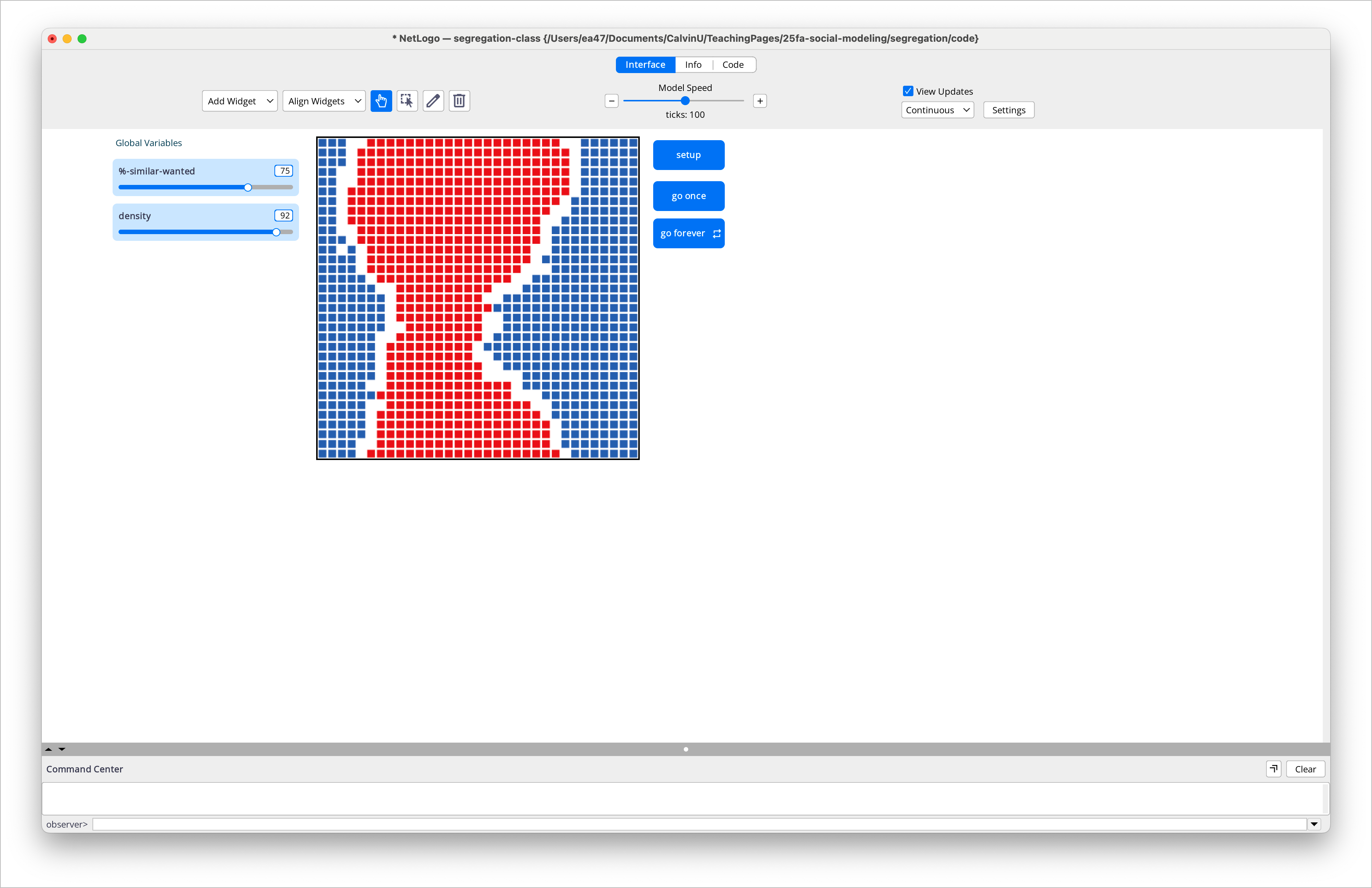So far we have been working on the setup of the model and the update of the households. Now we need to define the dynamics of the model. The dynamics will be defined in a procedure called go. This procedure will be called every tick of the simulation. In this procedure, we will ask the unhappy agents to move to a new location. We will also update the shape of the agents based on their happiness and update the global variables.
to go
if all households [happy?] [ stop ] ; stop the simulation if all agents are happy
move-unhappy-households ; procedure to move unhappy agents
update-households ; update the shape of the agents based on their happiness
update-global-variables ; update the global variables
tick ; increment the tick counter
endThe procedure to move the unhappy agents is as follows:
to move-unhappy-households
ask households with [not happy?] [
move-to one-of patches with [not any? households-here] ; move to a random empty patch
]
endFinally, we need to fill the update-global-variables procedure. This procedure will count the number of happy and unhappy agents and update the global variables accordingly.
to update-global-variables
set happy-households count households with [happy?] ; count happy agents
set unhappy-households count households with [not happy?] ; count unhappy agents
set proportion-similarity (sum [similarity] of households) / count households
endNow we can go back to the interface tab and create a button to call the go procedure. Make sure to set the button to “forever” so that it will keep calling the go procedure until all agents are happy. You can also create two buttons to call the go procedure (once and forever).

And this is the final code for our Segregation Model. You can now run the model and see how the agents move around the environment until they are all happy.
globals [
happy-households ; The number of happy agents in the model
unhappy-households ; The number of unhappy agents in the model
proportion-similarity ; proportion of similar households for the overall population
]
breed [households household] ; define a breed for the agents as a household
households-own [
happy? ; boolean indicating if the household is happy
similar-neighbors ; number of similar neighbors
different-neighbors ; number of different neighbors
total-neighbors ; total number of neighbors
similarity ; proportion of neighbors of the same color
]
to setup
clear-all ; clear the environment
make-households ; procedure to create the households
update-households ; procedure to update the shape of the households based on their happiness
update-global-variables ; procedure to update the global variables
reset-ticks ; reset the tick counter
end
to make-households
ask patches [
set pcolor white ; set all patches to white
if random-float 100 < density [
sprout-households 1 [ ; create a household with a probability defined by density
set color one-of [red blue] ; randomly assign red or blue color
set size 1 ; set the size of the household
]
]
]
end
to update-households
ask households [
set similar-neighbors count (households-on neighbors) with [color = [color] of myself]; count similar neighbors
set different-neighbors count (households-on neighbors) with [color != [color] of myself] ; count different neighbors
set total-neighbors similar-neighbors + different-neighbors ; total neighbors
ifelse total-neighbors > 0 [ set similarity (similar-neighbors / total-neighbors) * 100 ]
[ set similarity 100 ] ; if no neighbors, consider happy
set happy? (similarity >= similar-wanted)
ifelse happy? [ set shape "square" ][ set shape "x" ] ; set shape to x if unhappy and square if happy
]
end
to update-global-variables
set happy-households count households with [happy?] ; count happy agents
set unhappy-households count households with [not happy?] ; count unhappy agents
set proportion-similarity (sum [similarity] of households) / count households
end
to go
if all? households [happy?] [ stop ] ; stop the simulation if all agents are happy
move-unhappy-households ; procedure to move unhappy agents
update-households ; update the shape of the agents based on their happiness
update-global-variables ; update the global variables
tick ; increment the tick counter
end
to move-unhappy-households
ask households with [not happy?] [
move-to one-of patches with [not any? households-here] ; move to a random empty patch
]
end